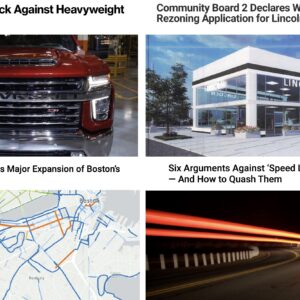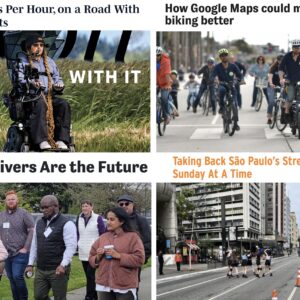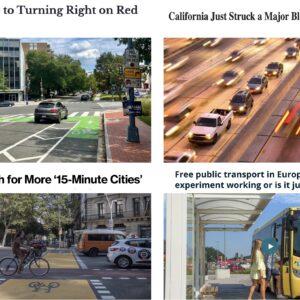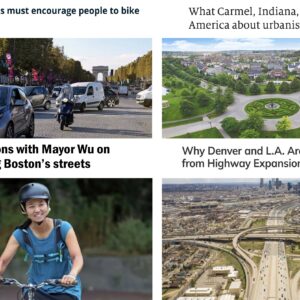Here’s the news that caught our eye this week:
– Attempts to stop the BP oil leak in the Gulf of Mexico have failed, and officials are now saying that it may continue gushing all summer or longer; it’s also now being called the largest environmental disaster in US history. Here’s how engineers say it started, and here are some sobering photos.
– While riding a bike in traffic you inhale five times as many toxic particles as you do in a car, finds a new study.
– And the public health research continues to roll in: the “hidden” health costs of car dependence are major, from illness brought on by inactivity to toxic pollution to the many costs associated with car crashes.
– An interesting, somewhat rambling look at bike infrastructure politics in Paris, Montreal, and Toronto.
– A proposal in the US Senate could offer aid to some transit agencies to stop or reverse service cuts and fare hikes.
– Do cars and freeways help or harm rural livability? It’s a controversial topic right now. Gary Toth weighs in.
– Being injured in a car crash may be an indicator for reduced standard of living.
– At the NY Times, a panel of experts weighs in on the question of: “Do we tolerate too many traffic deaths?”
– Two new companies hope to set up private car rental schemes between people who own cars and their neighbors who don’t.
– The mayor of Berkeley says he has “become a better mayor” since he sold his car and started walking to work a year ago.
– Do you identify as a cyclist? Or do you just ride a bike?
– Among these recollections of the Vanport flood in Portland in 1948, one man remembers pedaling to safe ground with his friends.






Thanks for reading.
BikePortland has served this community with independent community journalism since 2005. We rely on subscriptions from readers like you to survive. Your financial support is vital in keeping this valuable resource alive and well.
Please subscribe today to strengthen and expand our work.
i thought i had read somewhere that people inside cars are actually more exposed to pollutants than people outside.
http://www.epa.gov/nheerl/copp/
http://www.icta.org/doc/In-car%20pollution%20report.pdf
so, which is it?
How about this one: GMAC survey estimates almost 20% of people driving cars in US would fail driving test.
http://www.gmacinsurance.com/SafeDriving/PressRelease.asp
Another monday blog of “Bikes vs Cars”.
Do you want to “share the road” or “takeover the road”?
Share the road, but only because we have no alternative. Cars are dirty, dangerous, and destructive, and they’re not going away.
Whoa, Ely! Tone down your realistic and pragmatic world view before someone gets mad or starts weeping.
It has long been known, at least by me, that as Portland is the city with I believe the largest amount of trees within the city limits, that it makes cycling a dangerous venture, as far as breathing goes.
Though I believe less trees are downtown now, the effect of exhaust fumes trapped longer at ground levels by trees added to the risk of breathing while cycling….
JR – you should not be surprised at the 20% figure…as there are that many or more drivers driving without a drivers license/ insurance…these days. Look how easy it is to register a car for tabs and then cancel the insurance. Here in the UAE if that happens the vehicle is placed on a watch list if it does not have new insurance reinstated…their system is easier to enforce since it is the car VIN that must have insurance vs. being tied to the driver.
Overall it is kinda the hidden problem on our (US) roadways – many more vehicles with defects (broken lamps, windshields, emissions and other safety gear) than decades ago. I remember being more in fear driving around NJ vs. OR/ WA with a broken tail light…etc. Libertarian values?!
Perhaps someday the urban planning/ CPTED ‘broken window’ theory will filter down to our legislative leadership who will then engage the traffic police to address these safety issues with the same fervor as enforce the sit and lay policies on many sidewalks..
http://en.wikipedia.org/wiki/Crime_prevention_through_environmental_design
ARE…I was thinking of the same studies…good job!
…PS…any PSU students interested in this topic?
How about collecting some baseline air quality (and noise levels) samples during large bike and ped events (that close roadways to MV traffic)? Last Thursday in Alberta, BridgePedal, and Sunday Parkways would be great petri dishes of transport and emission research on how local MV traffic affects our communities.
I think most citizens would be shocked if they knew how few air quality monitoring stations most urban areas have…it usually is a handful (< than the number of Starbucks!).
As I always tell my traffic engineers…you only collect the data you care about…so if you have no data you cannot rule out the potential for a [bike or ped] condition.
Reading the Vanport article…the 40,000 population of Oregon’s second largest city of Vanport was similar to Vancouver – which also grew to absorb Kaiser workers and ALCOA workers…from 20K to 40K in a year…Vancouver’s city limits pre 1941 were basically south of 40th St and West of Grand Blvd (very bikeable and walkable)…where the sidewalk and alley network ends to this day. After the war the population dropped back into the 20k and took another 40 years to rise back up into the 40k…then up to 150k in a blink of a series of annexation votes after 1996.
While the increased wind drag caused by ground level vegetation is sure to cause some locally observed stagnation it has also been shown, don’t remember where, that trees also absorb solid and liquid particulates from the air. To reach a useful scientific conclusion you will need to also test a similar city, with similar building topography and weather, but much fewer trees.
I’m definitely somebody that rides a bike rather than a cyclist…
…
are #1, I read the same thing… it still makes sense… anybody near the road will get more pollutants… but I wonder if it’s 5x like the roadside cyclists…
also, some of the pollution inside a car comes from the materials it’s made of and not the pollution it’s creating…
Dabby, are you joking? I can’t tell and not a single thing in your comment seems believable.
Of course if you’re dumb enough to sit there next to the F350 exhaust pipe aimed at your face and not move I’m sure 5x the pollution level is realistic.
Must resist urge to speculate on the confluence of large passenger trucks, rude drivers and their exhaust pipes that aim to thee right hitting pedestrians.
The pictures of the oil spill are really a grim reminder of our dependence on oil.
Here’s the direct link from the story above.
http://www.boston.com/bigpicture/2010/05/oil_reaches_louisiana_shores.html
I am not joking..
Clean breathing is just another reason why the urban bike transportation network needs to evolve toward separated bike paths–ideally VERY separated. I wonder whether the right evolution of the bike boulevard concept should eventually restrict non-local (residential) auto travel?
If the article about pollutants frustrates you please attend the Gas Mask Ride on June 11 at 5:30pm and make a statement. Lillis Albina Park 2300 N Flint
http://www.shift2bikes.org/cal/viewpp2010.php#11-1506